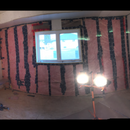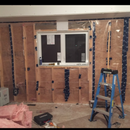Repairing polyethylene vapor barrier
Hi everyone,
We had had run into some condensation concerns after our original vapour barrier and insulation was installed, as such we had to take out the batts in some bedrooms to let the walls dry out with fans…
To get the batts out I had cut slits down every second stud in the bedroom.. upon putting the batts back in I’d had stapled the poly back to the stud and sealed the cuts with TUCK TAPE
Sheating Tape for PE Vapor Barrier (Blue Tuck Tape).
My question/concern with this is that is repairing large cuts in the vapour barrier in this manner an effective way to repair and maintain an effective vapour barrier.. or should I take down the sheets of poly and throw up fresh sheets of 6mil poly?
Some additional info:
– Climate Zone 7
– Wall assembly consists of 2×6 walls, with OSB sheathing, r24 batts and 6mil poly vapor barrier
GBA Detail Library
A collection of one thousand construction details organized by climate and house part











Replies
Rick,
I'm going to leave any comments about whether you need a poly VB to pother posters and just deal with your question.
I would have torn off the poly and replaced it. Much faster, less fussy work, and cheap to do. That said, if you taped the seams, and given that they all have backing behind them, there is nothing wrong with what you ended up with.
Edit: On looking more closely at your pictures, I would have done what you did. No way would I try and replace sheets of poly bedded in accoustal sealant.
Rick,
The brief answer is that your repair is fine.
That said, you should know that interior polyethylene vapor barriers often cause more problems than they solve. (I'm guessing that your house is in Canada, where the polyethylene vapor barrier still enjoys respect and legal protection.)
Your opening sentence is highly concerning: "We had run into some condensation concerns after our original vapour barrier and insulation was installed, as such we had to take out the batts in some bedrooms to let the walls dry out with fans."
My guess is that you are focusing on the wrong issue. The type of tape that you used to repair the poly is irrelevant. The big questions are: Where did the moisture come from? Will the moisture return? And is the polyethylene part of the problem instead of part of the solution?
To satisfy the curiosity of our community, I'd like to hear more information about the moisture problem.
-- Martin Holladay
thanks for your replies. My concern was that there were a couple of seams where the poly did not extend back to meet perfectly as their original state, and that the tape was not as effective of a VB as 6mil poly
Martin, my guess is that issue came from the batts being installed in cold weather while there was heat on in the house..and the poly not applied to cover the batts until the following day leading to condensation forming behind the batts then being sealed in. Of course those who installed originally will likely have a different theory..
Rick,
What air sealing steps did you take during construction? For example, did you tape or caulk the seams on the sheathing?
Rick,
Your theory about how the stud bays got damp is probably correct, and the sheathing will probably be OK -- especially if there is a drying path to the exterior.
Interior vapor barriers don't have to be perfect. Even a vapor barrier with lots of holes works just fine to stop vapor diffusion.
That said, you need an excellent interior air barrier. It's usually easier to detail the drywall as your air barrier rather than trying to use polyethylene as your air barrier. Try to seal air leaks at penetrations, especially at electrical boxes, and you'll probably be OK.
-- Martin Holladay
thanks Martin. as a follow up to that..we are currently boarding the walls with drywall now..any concerns with having heat going (furnace) in house during the drywall boarding process?
It is average around +8°C (46°F) during the day but overnight the temperatures are around -2°C (28°F).
I've sealed and caulked/taped the poly and all electrical boxes.. I gues the only concern now would be holes in the VB from drywalls screws during the boarding while warm air is heating the house. I may be overthinking it, but after taking out and redoing my insulation/VB.. I'd like to avoid any potential problems.
Steve, I caulked any seams in sheathing where I could see openings. Any seams with no daylight showing through I did not tape/caulk. Tyvek housewrap on the exterior of sheathing
Rick,
It's absolutely normal (and a good idea) to heat the interior of your house with your furnace during drywall hanging and taping.
-- Martin Holladay
Rick,
If you are going to use your furnace during drywalling it's best to close off the cold-air return vents in the areas being worked on to avoid filling your system with dust. Many builders prefer to use portable heaters for that reason.
Malcolm.
Good point. (Your advice is especially important when the drywallers start sanding the joint compound.)
-- Martin Holladay
Martin,
In your neck of the woods, is there still a lot of drywalling? I've heard anecdotally that blue board and a skim coat is becoming more popular in the East.
Malcolm,
I think plaster is more common on high-end homes in Massachusetts than in rural Vemont. I don't see much plaster.
Thanks for the advice Martin.
Another quick question re. The drywalling, I'll ask here rather than starting a new thread..
2 washrooms upstairs will have an outside wall.. I was planning on using greenboard on the walls in the washroom, however I have seen people advising against putting greenboard over a poly vapour barrier as this would create a double vapor barrier.. any thoughts on using greenboard over poly or should I just use regular drywall boards on the outside walls?
Thanks
Rick,
If you are installing a poly vapour barrier you can use green board, dense-shield or any other substrate you want. Double vapour barriers are only a potential problem if they are are on opposite sides of a material that might get wet and have no path to dry ( like having them on both sides of a wall).
Rick,
Q. "I have seen people advising against putting greenboard over a poly vapour barrier as this would create a double vapor barrier.. any thoughts on using greenboard over poly or should I just use regular drywall boards on the outside walls?"
A. Malcolm gave you the right answer: Don't worry.
For more on this issue, see Worries About Trapping Moisture.
-- Martin Holladay